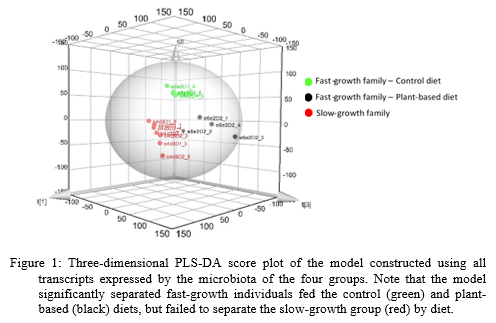DIET AND HOST GENETIC BACKGROUND DRIVE DIFFERENCES IN THE TRANSCRIPTOMIC PROFILE OF INTESTINAL MICROBIOTA IN GILTHEAD SEA BREAM
Introduction
In the animal production sector, there is an increasing interest in manipulating intestinal microbiota due to their undeniable key effects on host health and welfare. To that aim, numerous studies have been conducted in order to define microbial populations and changes in fish intestine under different conditions. However, most of the studies conducted so far are focused on describing the presence and abundance of bacterial populations based on DNA sequencing technologies. In the current study, we aimed to define the actual metabolic potential of fish intestinal resident microbiota, by studying the gene expression of all gut microbes instead of just defining presence/absence of bacteria. To that aim, we used two families of gilthead sea bream (Sparus aurata) selected for heritable growth (fast- and slow-growth families) and fed control or plant-based diets. In previous studies, the fast-growth family showed a more continuous growth across seasons, genetically regulated intestinal plasticity to maximize nutrient absorption when fed plant-based diets, improved resilience to intestinal parasites, and a plastic microbiota that efficiently adapted to the metabolic challenges induced by diet changes (Perera et al ., 2019; Piazzon et al., 2020). Upon diet changes, only a small percentage of the adherent bacterial populations changed in the fast-growth family , but these small changes seemed to account for higher metabolic changes (inferred metagenome and pathway analysis) when compared to the slow-growth family . Here, we compare the transcriptional profile of the total microbial populations in fast- and slow-growth families in order to validate and have further details on the previous observations.
Methods
Two gilthead sea bream families, selected for fast- (e6e2) and slow-growth (c4c3) were kept together in the same open-flow tanks and fed a control or a well-balanced plant-based diet during nine months. Eight animals per group were sacrificed and the adherent microbiota from the anterior intestinal portion was collected and used for RNA extraction. RNA samples were pooled in groups of two to yield a total of four samples per group. After rRNA removal, RNA was sequenced (Illumina, 150PE). Reads were quality filtered and the transcriptome was reconstructed using Trinity. For annotation, the obtained unigenes were aligned with Bacteria, Fungi, Archaea and Viruses sequences from the NCBI’s NR database using Diamond. Partial least squares discriminant analyses (PLS-DA) and DESeq2 were used to determine group differences and differentially expressed genes among groups. Gene ontology analysis was performed using GOSeq.
Results
The total number of annotated transcripts found in this study was 35,144, from which 232 (0.7%) were Archaea, 17,516 (49.8%) Bacteria, 15,703 (44.7%) Fungi, and 1,693 (4.8%) Virus. Regarding the level of expression of the transcripts per group and organism, no differences were detected between families, but differences were found between dietary groups . Plant-based diets increased the number of Fungi transcripts and decreased bacteria transcripts . Diet and genetic background were responsible for changing the expression of 425 and 329 transcripts, respectively. PLS-DA analysi s showed a significant separation between fast- and slow-growth families, and within the fast-growth family the different diets showed a significantly different profile. However, diet driven differences were not detected in the slow growth family (Fig. 1) . This was supported by the DESeq2 analysis which showed a change in 271 transcripts in the fast-growth family when fed different diets, whereas only 40 differentially expressed transcripts were found in the slow-growth group. GOSeq analyses revealed that plant-based diets were upregulating genes involved in anatomic structure morphogenesis and development, and downregulating genes involved in several metabolic pathways, lipid localization, cytolysis and killing of cells of other organisms, and response to stress in the fast-growth group . Downregulation of vitamin metabolism and upregulation of carbohydrate metabolism, cytokine production, movement and entry into host, and cell proliferation was found in the slow growth group.
Conclusions
Fungi and Bacteria transcripts constitute almost 95% of the transcriptome of gilthead sea bream intestinal microbiota and Fungi transcripts are found roughly in the same abundance as bacterial, highlighting the importance of these two groups of microorganisms in the metabolism of intestinal microbiota. Microbial expression of genes related to tissue remodelling in fast-growth families when fed plant-based diets indicate a possible role of the microbiota in intestinal reshaping (Perera et al ., 2019). Gene expression patterns found in the slow-growth family indicate a shift towards inflammation and bacterial invasion when these animals are fed plant-based diets. The current results support the previous findings describing fast-growth families’ microbiota as plastic communities able to achieve large metabolic changes with fewer changes in the bacterial composition (Piazzon et al ., 2020) allowing the animals to efficiently adapt to diet changes. These results highlight the relationship between selection for heritable growth and metagenome and the impact o n animal health and ability to adapt to changes without detrimental effects.
References
Perera E., Simó-Mirabet P., Shin H.S., Rosell-Moll E., Naya-Català F., De las Heras V., et al . 2019. Selection for growth is associated in gilthead sea bream (Sparus aurata ) with diet flexibility, changes in growth patterns and higher intestine plasticity. Aquaculture, 507:349–360.
Piazzon M.C., Naya-Català F ., Perera E., Palenzuela O., Sitjà-Bobadilla A., Pérez-Sánchez J. 2020. Genetic selection for growth drives differences in intestinal microbiota composition and parasite disease resistance in gilthead sea bream. Microbiome, 8:168.
Acknowledgements : AquaIMPACT (H2020 #818367); Bream-AquaINTECH (RTI2018–094128-B-I00) ; RYC2018-024049-I/AEI/10.13039/501100011033.
